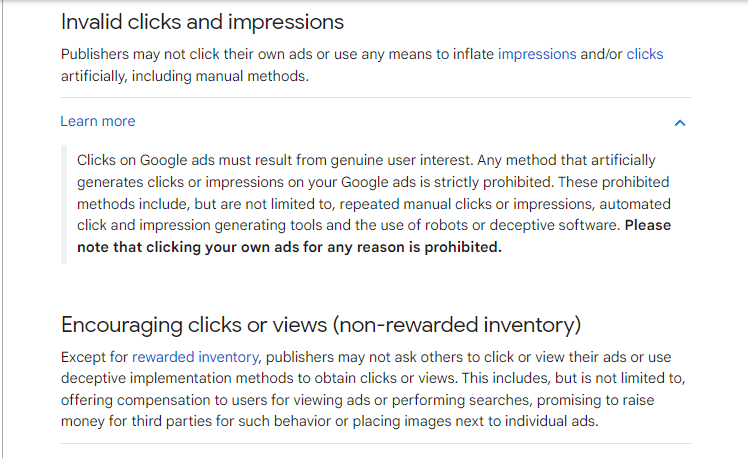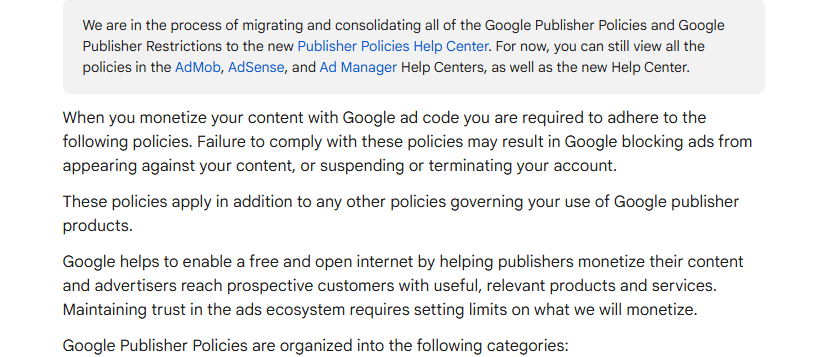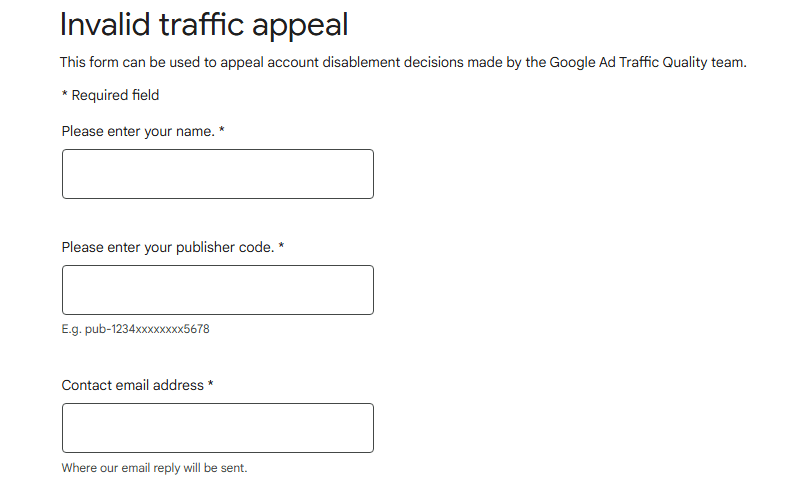Google AdSense is one of the most popular ad networks that allows website owners to monetize their content by displaying ads on their websites. However, sometimes AdSense bans users for invalid traffic, a situation where a user’s AdSense account is suspended or banned due to suspicious activities such as fraudulent clicks, impressions, and bot traffic. You are probably on this page looking for how to appeal an AdSense ban due to invalid traffic
If you have been banned from AdSense for invalid traffic, you can appeal the decision by following the step-by-step process in this post, though the chance of getting your account reinstated is very slim.
Today, I will guide you through the appeal process of the AdSense ban due to invalid traffic and help you understand what invalid traffic is and how to prevent it.
How to Appeal an AdSense Ban for Invalid Traffic in 2025 Share on XTable of Contents
What is Invalid Traffic?
Invalid traffic is any activity that artificially increases ad impressions or clicks or any activity that may artificially inflate the click-through rate (CTR) of ads. Invalid traffic can be caused by human or bot activities and can be intentional or unintentional.
Examples of invalid traffic include:
- Clicking on your ads
- Asking others to click on your ads
- Using automated tools or software to generate clicks or impressions
- Buying traffic or clicks from a third-party service
- Participating in click exchange programs
- Posting ads on websites that violate AdSense policies
- Using bots or proxies to generate clicks or impressions
- Accidentally clicking on your ads

How Does Google AdSense Detect Invalid Traffic Sources?
Google AdSense uses various techniques and tools to detect invalid traffic sources. These tools analyse website traffic and user behaviour to identify patterns indicative of invalid traffic. Google AdSense uses a combination of technological filters, human reviews, machine learning, and other advanced techniques to detect invalid traffic sources.
With these series of techniques, Google AdSense can identify and take action against invalid traffic to protect the integrity of the AdSense program and ensure that advertisers get the best value for their advertising dollars.
Some of the methods used by AdSense to detect invalid traffic sources include the following:
- Automated Filters
Google AdSense uses automated filters to detect invalid traffic sources. These filters analyze various metrics such as clicks, impressions, click-through rate (CTR), and bounce rate to identify unusual patterns that may indicate invalid traffic.
- Manual Review
Google AdSense also has a team of human reviewers who manually review accounts for invalid traffic. These reviewers analyze account activity and website traffic to identify any unusual patterns that may indicate invalid traffic.
- Machine Learning
Google AdSense also uses machine learning algorithms to detect invalid traffic. These algorithms analyse historical data and user behaviour to identify patterns indicating invalid traffic.
- IP Address Analysis
Google AdSense uses IP address analysis to detect invalid traffic. If a large number of clicks or impressions are coming from a single IP address, it may indicate that the traffic is not legitimate.
- User Behaviour Analysis
Google AdSense analyses website user behaviour to detect invalid traffic. If users click on ads repeatedly or for an extended period, it may indicate that the traffic is not legitimate.
- Click Fraud Detection
Google AdSense uses click fraud detection tools to detect invalid traffic. These tools analyse metrics such as click frequency, click patterns, and click location to identify suspicious activity.
- Geolocation Analysis
Google AdSense also uses geolocation analysis to detect invalid traffic. If a large number of clicks or impressions are coming from a single location, it may indicate that the traffic is not legitimate. For example, if your traffic has been coming from the USA and suddenly you have large traffic clicking on Ads from India or China.
Why is Invalid Traffic Bad for the Publishers
Invalid traffic can have a serious negative impact on your blog. As a publisher, you must prevent invalid traffic on your blog and comply with AdSense policies to avoid negative impacts on your account, revenue, and reputation. Invalid traffic can harm your blog in many ways. Here are a few reasons why you must prevent invalid traffic on your blog:
Account Suspension or Termination: Invalid traffic can lead to getting your AdSense account suspended or terminated. This can be devastating if you rely on AdSense as a source of income for your blog.
Loss of Revenue: Invalid traffic can result in a loss of your blog revenue because invalid clicks or impressions are not counted toward earnings. If too much invalid traffic is detected on your blog, you may lose all your AdSense earnings.
What to do if Your Account was Suspended Due to Invalid Traffic
Google AdSense takes invalid traffic very seriously. This means that if AdSense thinks there is a risk to advertisers on your blog, it might suspend or disable your account.
It’s important to understand the difference between suspension and disabling.
If your account is suspended because of invalid traffic, the ad serving will stop for a specific period, usually 30 days. After that period, the account will be automatically cleared if there are no issues.
If your account is disabled, it can’t serve ads, and you won’t be able to use any Google ad programs in the future.
How to Appeal an AdSense Ban for Invalid Traffic
When your AdSense account is banned for invalid traffic, you will receive a notification from Google stating that your account has been suspended or terminated. This means that you will no longer be able to display AdSense ads on your website and will not be able to earn any revenue from the AdSense program.
Google takes invalid traffic very seriously because it can harm the integrity of the AdSense program and advertisers’ trust. Therefore, Google has a strict policy regarding invalid traffic, and it thoroughly investigates all suspected cases before taking action.
If you believe your account has been banned for invalid traffic by mistake or have taken corrective measures to prevent invalid traffic, you can appeal the decision by following the steps below.
- Understand the Reason for the Ban
Before appealing the AdSense ban, it is essential to understand the reason for the ban. You can check the reason by logging into your AdSense account and checking the notifications section. In most cases, Google will provide details about the invalid traffic activity that led to the ban.
- Review AdSense Policies
Next, review AdSense policies to ensure your website complies with all the policies. You can review the AdSense policies by visiting the AdSense help center. Make sure that your website does not violate any of the AdSense policies.

Use this time to review AdSense policies carefully and ensure your website or app is fully compliant. Look for any violations that could have led to the suspension and take corrective actions as needed.
- Identify and Correct the Invalid Traffic Source
After reviewing AdSense policies, you need to identify the source of invalid traffic and take corrective measures to prevent it. If bots cause invalid traffic on your website, you can use a bot detection tool to block them from accessing it. If the invalid traffic is caused by human activity, you need to identify the source and take corrective measures to prevent it.
Review your traffic logs and analytics data to identify suspicious activity or traffic sources; you can use Google Analytics 4 or any other reliable analytic tool to review your traffic source.
This could include repeated clicks from the same IP address or a high bounce rate from a specific location. Find the sources of invalid traffic, and block suspicious traffic because if additional issues are found during, or after the suspension period, your AdSense account can be disabled.
- Improve Your Content
Focus on improving your website’s content during the suspension. Ensure your content is high-quality, relevant, and engaging for your audience.
- Build Your Traffic Organically
Avoid using any illegal method that could lead to invalid traffic during the suspension period. Instead, focus on building your traffic organically by improving your search engine optimization (SEO), social media presence, and other marketing efforts.
- Submit an Appeal
Once you have identified and corrected the invalid traffic source, you can submit an appeal by filling out the invalid traffic appeal form. You will need to provide details about the invalid traffic activity, the corrective measures you have taken, and the steps you will take to prevent future invalid traffic.

It is crucial to provide as much information as possible in the appeal to convince Google that you have taken corrective measures and are committed to preventing future invalid traffic.
Note: There’s no guarantee that your AdSense account will be reinstated, but Google always does its best to review your appeals and inform you as quickly as possible.
- Wait for a Response
After submitting the appeal, you will need to wait for Google AdSense to review your appeal and get back to you.
Can the AdSense Account be Reinstated after the Appeal?
Yes, it is possible to have your AdSense account reinstated after your appeal. Google takes careful measures and investigates each case with a team of specialists, considering the interests of advertisers, publishers, and users.
If the appeal gets denied, the possibility of reinstatement is low. If your AdSense account gets reinstated, it can take up to 2 days for all Google servers to be informed of the change and for your account to be active again to serve ads.
What to do if Your Appeal is Denied?
If your appeal is denied and the account stays disabled, there isn’t much you can do with the existing account. You may not be able to open a new account after the ban. But while your AdSense account is banned, you can consider other monetization options for your website.
There are many other ad networks you can apply to, affiliate programs, and sponsored content opportunities that can help you earn revenue even higher than what Google AdSense will offer you.
Final Thoughts
Receiving an AdSense ban due to invalid traffic can be a challenging and frustrating experience for anyone whose blog source of revenue is Google AdSense. However, it’s important to understand the seriousness of invalid traffic and take steps to prevent it from happening in the future.
I have just shown you how to appeal an AdSense ban, if your AdSense account gets suspended or disabled, you should first review AdSense policies and ensure your website or app is following them correctly. Then, check for any suspicious activity or traffic sources and remove them. After taking these steps, you can submit an appeal to AdSense support and provide any relevant data or evidence to support your case.
Remember to be patient during the appeal process and avoid resubmitting your appeal unless asked. Lastly, during the suspension, focus on improving your website and consider other monetization options to keep earning revenue. With the right approach, you can increase your chances of reinstating your AdSense account and avoid future invalid traffic issues.
If you enjoy this article on how to Appeal an AdSense Ban for invalid traffic, kindly share it with your friends on social media. If you have any questions regarding the AdSense ban or want to share your AdSense ban experience with us, leave a comment below.
- How to Prevent Your AdSense Account from Getting Banned
- 6 Verified Ways to Increase AdSense CPC and Boost Your Earnings
- Can You Use AdSense and Affiliate Ads on the Same Website
Frequently Asked Questions (FAQs)
Why was my AdSense account banned for invalid traffic?
Google AdSense bans accounts for invalid traffic to protect advertisers from fraudulent or unintentional clicks and impressions that could skew ad performance. Common reasons include:
Clicking on your own ads.
Encouraging others to click on your ads.
Receiving automated or bot-generated traffic.
Irregular activity detected by Google’s algorithms.
Can I appeal an AdSense ban for invalid traffic?
Yes, you can appeal the ban by submitting an appeal form through your AdSense account. The appeal process allows you to explain the situation, provide details about your traffic sources, and prove that the invalid traffic was unintentional or outside your control.
How do I write a strong appeal for an AdSense ban?
To write a strong appeal, follow these steps:
Acknowledge the issue: Show you understand the problem and take it seriously.
Explain your actions: Detail the steps you’ve taken to investigate and prevent invalid traffic (e.g., analyzing traffic sources).
Provide evidence: Share screenshots, analytics data, or other relevant information that supports your case.
Be honest and professional: Avoid blaming Google or making emotional arguments.
Submit timely: Appeals should be made promptly, as delays could weaken your case.
What can I do if my AdSense appeal is denied?
If your Google AdSense appeal is denied, consider these Google AdSense alternatives or explore other monetization options like affiliate marketing and sponsored content





0 Comments